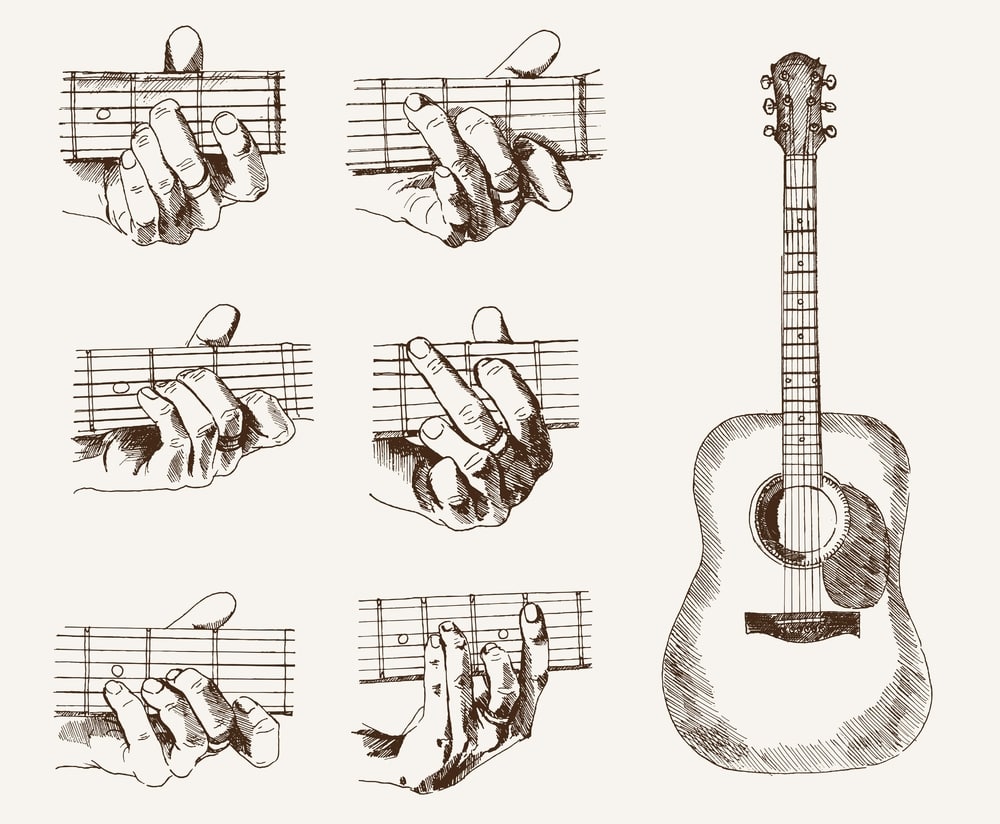Are you guitar-practice-routine-how-to-get-better-faster/” title=”Guitar Practice Routine – How To Get Better Faster”>tired of feeling like your fingers are doing the cha-cha every time you try to switch between chords on the guitar? Fear not, because we’ve got the inside scoop on how to master smooth chord changes like a pro. Say goodbye to those awkward pauses and missed notes – it’s time to level up your guitar game with some expert tips that will have you strumming seamlessly in no time. So grab your guitar, limber up those fingers, and get ready to become a chord-changing maestro!
Contents
- 1 Understanding the Foundation of Chord Transitions
- 2 The Role of Hand Positioning in Seamless Chord Changes
- 3 Exploring Common Techniques for Faster Chord Shifts
- 4 Breaking Down the Barrier: Moving Beyond Basic Chord Shapes
- 5 Incorporating Muscle Memory Training into Practice Sessions
- 6 Elevating Your Practice: The Importance of Slow, Deliberate Repetition
- 7 Navigating Complex Chord Progressions with Ease
- 8 FAQs
- 9 Time to Strum Like a Pro!
Understanding the Foundation of Chord Transitions
So, you want to master the art of chord transitions, huh? Strap in, my friend, because we’re about to dive deep into the very foundation of this musical magic trick.
First things first, let’s talk about the importance of knowing your chords. It’s like knowing your ABCs before trying to write a novel – you can’t build a beautiful musical masterpiece without a solid understanding of the building blocks. So, bust out that chord chart and start memorizing those shapes like your musical future depends on it – because it does!
Next up, it’s time to practice those transitions like a boss. Think of it like a game of musical Tetris – each chord is a block that needs to fit perfectly with the next one. Play around with different finger placements, experiment with various strumming patterns, and don’t be afraid to get a little creative. Remember, Rome wasn’t built in a day, and neither will your flawless chord transitions.
And finally, don’t forget to have fun with it! Music is all about expression and enjoyment, so don’t stress too much about hitting every chord perfectly every time. The journey to mastering chord transitions is just as important as the destination, so embrace the process, laugh at your mistakes, and keep on strumming away!

The Role of Hand Positioning in Seamless Chord Changes
When it comes to playing guitar, hand positioning is crucial for achieving seamless chord changes. It’s like the secret sauce that makes all the difference between sounding like a rockstar and sounding like a cat being strangled.
Here are some tips to help you nail down your hand positioning and make those chord changes flow like butter:
- Fingers like spaghetti noodles: Keep your fingers relaxed and flexible, like a bowl of cooked spaghetti. Stiff fingers are a recipe for disaster when trying to switch between chords.
- Thumb placement: Your thumb should always be behind the neck of the guitar, acting as a support and a pivot point for your hand to move around smoothly.
- Curved fingers are happy fingers: Make sure your fingers are curved and not flat against the fretboard. This allows for better reach and more accurate placement of your fingers on the strings.
Remember, practice makes perfect! So spend some quality time with your guitar and work on getting your hand positioning just right. Your fingers will thank you, and your audience will be left wondering how you make those chord changes look so effortless.

Exploring Common Techniques for Faster Chord Shifts
Learning to shift chords quickly is a skill that can take your guitar playing to the next level. With a little practice and some handy techniques, you’ll be rocking out in no time!
One common technique for faster chord shifts is preparing your fingers ahead of time. Instead of waiting until the last second to move your fingers to the next chord shape, try positioning them close to where they need to be before you make the switch. This will help you cut down on transition time and make your playing smoother.
Another helpful trick is to focus on using your fingertips to press down the strings. By using the tips of your fingers instead of the pads, you’ll have more control and be able to switch chords more quickly. It may take some practice to get used to this technique, but it can make a big difference in your playing.
Finally, practice transitioning between chords using a metronome. Start slow and gradually increase the tempo as you get more comfortable. This will help you develop muscle memory and train your fingers to move more efficiently. Plus, you’ll feel like a total rock star when you nail those chord shifts at top speed!

Breaking Down the Barrier: Moving Beyond Basic Chord Shapes
Are basic chord shapes holding you back from reaching your full potential as a guitarist? It’s time to break down that barrier and move beyond the same old, boring patterns you’ve been stuck in. With a little practice and determination, you can start exploring new and exciting chord shapes that will take your playing to the next level.
One key strategy for moving beyond basic chord shapes is to experiment with different voicings. Try inversions, add9 chords, and even strange, dissonant shapes that will challenge your fingers and your ears. Don’t be afraid to get a little weird with it – after all, that’s where true creativity thrives!
Another way to break out of the box is to explore alternative tunings. Drop D, open G, and DADGAD are just a few examples of tunings that can open up a whole new world of chord possibilities. Plus, playing in alternative tunings will keep you on your toes and prevent you from falling into the same old ruts.
So, don’t be afraid to push yourself outside of your comfort zone and try new things. The world of guitar playing is vast and full of endless possibilities. By moving beyond basic chord shapes, you’ll unlock a whole new level of creativity and musicality that will set you apart from the rest. So grab your guitar, unleash your inner rock star, and start breaking down those barriers today!

Incorporating Muscle Memory Training into Practice Sessions
So you’ve decided to spice up your practice sessions by incorporating muscle memory training? Good choice! Muscle memory is like having your own personal autopilot for your body. With proper training, you’ll be able to perform complex movements without even thinking about it. Here are some tips to help you get started:
First things first, you’ll need to focus on repetition. The more you practice a certain movement, the more ingrained it becomes in your muscle memory. Repetition is key, so don’t be afraid to do the same drill over and over again until it becomes second nature.
Next, try breaking down complex movements into smaller, more manageable parts. This will make it easier for your brain to digest and for your muscles to remember. Think of it like trying to eat a giant pizza in one bite – it’s much easier to take it slice by slice.
Finally, mix things up! Incorporate different drills and exercises into your practice routine to keep things interesting. Your muscles will thank you for the variety, and you’ll be well on your way to becoming a muscle memory master in no time.
Elevating Your Practice: The Importance of Slow, Deliberate Repetition
Have you ever heard the saying “practice makes perfect”? Well, turns out there’s some truth to that. It’s not just about mindlessly going through the motions, though. To truly elevate your practice, you need to focus on slow, deliberate repetition. This is where the magic happens, folks.
Picture this: you’re a Jedi knight training with a lightsaber. Do you think Luke Skywalker became a master overnight? No way! It took countless hours of slow, deliberate repetition to perfect his skills. Just like ol’ Luke, we too must embrace the power of focused practice to reach our full potential.
Think of slow, deliberate repetition as your secret weapon. It’s like leveling up in a video game – each time you practice a skill with intention and precision, you’re gaining experience points. Before you know it, you’ll be wielding your lightsaber like a pro or mastering that tricky guitar solo.
So, next time you’re tempted to rush through your practice session, remember the importance of slow, deliberate repetition. Take your time, focus on each movement or note, and watch as your skills soar to new heights. May the force of deliberate practice be with you!
So you think you can handle complex chord progressions, huh? Well, buckle up because we’re about to take you on a wild ride through the world of music theory!
First things first, when faced with a tricky chord progression, it’s important to break it down into smaller, more manageable chunks. Think of it like trying to eat a giant sandwich – you wouldn’t shove the whole thing in your mouth at once, would you? No, you take it one bite at a time.
Next, familiarize yourself with the different types of chords you’ll encounter. Major, minor, augmented, diminished – they’re all part of the big, beautiful chord family. Don’t be intimidated by their fancy names, just think of them as your musical friends who are here to help you create sweet, sweet harmonies.
Now, let’s talk about chord voicings. These bad boys are like the secret sauce that takes your chord progressions from bland to grand. Experiment with different inversions and positions to find the perfect sound for your song. And remember, there’s no wrong way to play a chord – unless, of course, you accidentally hit a cat on the piano. Please don’t do that.
FAQs
What do I do if I keep messing up my chord changes?
Well, first of all, don’t panic! Take a deep breath and slow down. Practice each chord change individually before trying to put them together. Remember, Rome wasn’t built in a day, and neither were perfect chord changes.
How can I make my chord changes smoother?
Practice, practice, practice! Repetition is key when it comes to mastering anything, and chord changes are no exception. Start off slowly and gradually increase your speed as you become more comfortable with the changes. Before you know it, you’ll be switching between chords like a pro!
Are there any shortcuts to mastering chord changes?
While there are no magic tricks to instantly becoming a chord change ninja, there are a few tips that can help speed up the process. Try visualizing the chord shapes in your mind before playing them, or use a metronome to help keep you on beat. And remember, patience is a virtue!
What should I do if I just can’t seem to get the hang of a particular chord change?
First off, don’t get discouraged! Everyone struggles with certain chords at some point. If you’re having trouble with a specific change, focus on that one until you feel more comfortable. Break it down into smaller parts and practice them individually. Remember, slow and steady wins the race!
Time to Strum Like a Pro!
So there you have it, aspiring guitar gods and goddesses! With these expert tips on mastering smooth chord changes, you’ll be shredding like a pro in no time. Remember, practice makes perfect – so get those fingers moving and don’t be afraid to get a little funky with your strumming. Before you know it, you’ll be wowing audiences and turning heads with your flawless chord transitions. So grab your guitar, crank up the amp, and let’s rock and roll!



